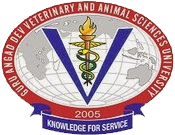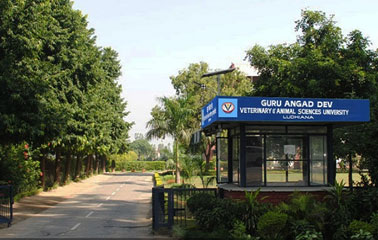

|
Sr. No. |
Title of Project |
Objectives |
Investigators |
Budget In lacs |
Sponsoring Agency |
Duration of the Project |
|
1. |
Studies on Intra-vitam diagnostic approaches of rabies in animals |
To study the Intra-vitam diagnostic approaches of rabies in animals |
PI: Dr. C. K. Singh
|
9.175 |
UGC, New Delhi
|
2012-2015 |
|
2. |
Studies on lymphangiogenesis in canine model of human breast cancer |
To study the expression of the lymphangiogenic markers in canine tumor.
|
PI: Dr. N. K. Sood |
9.35 |
UGC, New Delhi |
2012-15 |
|
3. |
Studies on epithelial-mesenchymal transition (EMT) in acute and chronic lung injury |
a) To evaluate the light and ultrastructural changes in the lung. b) To quantitate the expression of biomarkers of EMT in the lung. c) To correlate the structural changes with EMT biomarkers expression. d) Therapeutic approaches using anti-fibrotic herbal drugs, like baicalein/ Salvianolic acid B. |
PI: Dr. N.D. Singh |
21.60 |
SERB, DST, New Delhi |
2015-2019 |
|
. 4. |
Rapid and confirmatory detection of important animal meat based food borne pathogens and its associated toxicants and natural toxicants by using immuno-histopathological and molecular techniques- A step towards One Health Concept |
1. Study on tissue specific distribution of various zoonotic pathogens/ antigen across thecarcass by employing immuno-pathological techniques (immunohistochemistry). 2. Development of species specific or genus specific oligonucleotide probes to validate the presence of already established infections in carcass by employing in-situ hybridization techniques (ISH). 3. Utilization of species specific primers and probes to detect the actual load of pathogens in various organs, besides determining the pathogen load specific induction of gross /microscopic lesion at various organs by employing real time quantitative PCR (RT-PCR) techniques. Additionally, this technique can be utilized in live animals by using their collected blood samples. 4. Isolation of organisms in suspected mixed infections and characterization of closely related bio-transformation if any, by using PCR based restricted fragment length polymorphism (RFLP) techniques. |
PI: Dr. H.S. Banga Co PI: Drs. S. Deshmukh, R.S. Brar, N.D. Singh, APS Brar, P. Dwivedi and N. Mehta
|
43.0 |
MOFPI SERB (DST), New Delhi |
2016-2019 |
|
5. |
Comprehending the role of mucosal associated immunity during pathogen interaction following Avibacterium paragallinarum infection in poultry (chicken and Japanese quail) for developing a futuristic mucosal vaccine |
1. To understand route of invasion of Avibacterium paragallinarum and its interaction with various immune cells/tissue of hosts following primary contact. 2. To understand sequential and dynamic development of mucosa-associated immune response following an exposure to both live and inactivated/attenuated bacterium. 3. To compare immuno-pathogenetic mechanisms between different serovars in single host i.e. chickens to better understand the associated immunopathologic process and histopathological alteration. 4. To study comparative difference in immuno-pathological manifestation of infection between different hosts’s i.e. chicken and Japanese quail. |
PI: Dr. S. Deshmukh Co PI: Dr. H.S. Banga, Dr. Anish Thakur, Dr.R. S. Brar and Dr. S. Sodhi
|
29.50 |
DST, New Delhi |
2016-2019 |
|
6. |
Understanding in situ- dynamics of provincial innate immune response during reproductive salmonellosis in chicken for considering future practice of anal (cloacal) mucosal vaccination” |
1. To study in-situ demonstration of bacterial uptake/entrance within chicken’s reproductive tract to assess its putative pan reproductive localization in uterus to evaluate maximum demographic zone/tissue specific tropism of bacterium (Salmonella organism). 2. To explore spatial distribution and in situ tissue expression of m RNA transcripts of some selective immune relevant genes, specific toll like receptors (TLR) and defensin molecules in female reproductive tract of chicken following infection with Salmonella organism (Poultry specific sero vars). Customized locked nucleic acid (LNA) probe will be utilized for this technique and in situ-hybridization technique will be developed and operated. 3. To demonstrate emergence of chicken specific dendritic cells population(s), macrophage(s) and other adaptive immune component and its possible anatomical localization within female reproductive tract (Formalin fixed paraffin embedded (FFPE) tissue) of chicken following Salmonella infection(s) (Poultry specific sero vars) through immunohistochemistry. The difference in the relative proportion of these important markers would help us in identifying immune component important in restricting infections and resolution of infections in protected birds. 4. To demonstrate action of localized secretory antibody response in mitigating the harmful influence of Salmonella infection at various regions of chicken’s reproductive tract. |
PI: Dr. S. Deshmukh Co PI: Drs. S. Sodhi, R. S. Brar and H S Banga |
35.079 |
DBT, New Delhi |
2017-2020 |
|
. 7. |
Studies on patho-morphological alterations in blood cells to develop a foldscope based field test |
Studies on patho-morphological alterations in blood cells to develop a foldscope based field test |
PI: Dr. C.K.Singh Co PI: Drs. Kuldip Gupta and Vishal Mahajan
|
6.0 |
DBT |
2018-2019 |
|
8. |
Immunopathological and molecular studies on bovine cryptosporidial diarrhea and associated etiologies |
1. To diagnose C. parvum and associated etiological agents in field cases of bovine calf diarrhea. 2. To compare the diagnostic efficacy of conventional, immunopathological and molecular techniques in infectious bovine calf diarrhea. |
PI: Dr. APS Brar Co PI: Dr. B.S. Sandhu, Dr. Deepti Narang, Dr. C.K.Singh, Dr. Kuldip Gupta and Dr. N.K.Sood |
24.67 |
SERB, New Delhi |
2018-2022 |
|
9. |
A Centre of Advanced Faculty Training (CAFT) in the Department of Veterinary Pathology |
To provide hands-on-training to the young scientists, faculty and researchers. |
PI: Dr. C. K. Singh Co PI: Dr. Kuldip Gupta Dr. ND Singh |
11.415 |
ICAR |
2017 onwards |
|
10. |
To strengthen the research facilities in the Department of Veterinary Pathology under the (DST) FIST program |
To strengthen the research facilities in the Department of Veterinary Pathology |
PI: Dr. C. K. Singh Co PI: Dr. Kuldip Gupta and Dr. N.D. Singh
|
58.00 |
DST, New Delhi |
2018 onwards |
